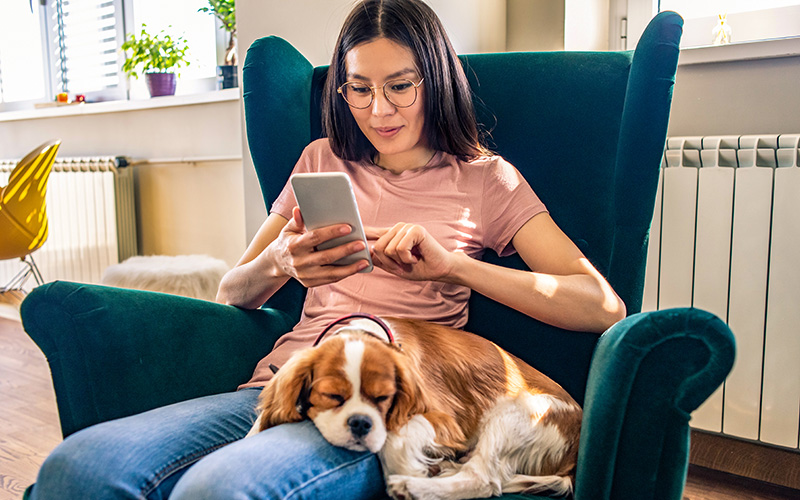Given the relative infancy of veterinary telemedicine adoption, many veterinary practices remain hesitant to adopt telemedicine because of three lingering myths:
- “Telemedicine platforms are unnecessary when there are free video chat tools like Zoom.”
- “The need for telemedicine will disappear once COVID-19 and curbside care are over.”
- “Using telemedicine will require extra time, and I don’t have extra time.”
As understandable as these beliefs can be, here are the facts:
Free Video Chat Software Can Cost Practices
Free video chat software has many limitations for veterinary practices that can reduce efficiency and cost time and money:
- Free video chat software does not automatically sync data from online consultations to practice management system medical records. So, all patient information exchanged prior to or during Zoom consultations (including text, pictures, and video) must manually be entered into patient medical records. This costs time and labor (which have dollar values) and reduces efficiency.
- Free video chat software does not have asynchronous communication and is designed for synchronous conversations (i.e. real-time face-to-face communication), which naturally present scheduling challenges for veterinarians or team members and create time inefficiencies for busy practices.
- Free video chat software does not have veterinary-specific tools and features like an AI-driven teletriage Symptom Checker built right into the platform and does not allow practices to invoice or collect payments from clients directly from the platform.
Telemedicine Is Here to Stay
In a recent video interview with NAVC Editorial Director Patricia Wuest for the Veterinary Virtual Care Association, Mark Cushing, CEO and Founder of Animal Policy Group, cites how human telemedicine took off some 30 years ago to serve people in rural areas who weren’t receiving medical care because they could not physically reach a doctor. And he sees veterinary telemedicine growing for the same reason—increased access and convenience for people who may otherwise not be able to visit a veterinary clinic in person.
Cushing uses the example of an elderly woman who owns a cat and lives on the seventh floor of an urban apartment building. In order to physically see a veterinarian, the woman would have to “put [the cat] in a crate, if she can pull that off, go down seven floors, walk out to the bus stop, get on a bus, make three connections, and walk to a clinic. Who are you kidding? [She’s] not going to do that.” As a result, the woman’s cat may not get the veterinary care it needs, even though the woman is a loving cat owner who’d be more than happy to pay for veterinary care.
Because many veterinary practices have already seen how telemedicine increases access to veterinary care, in addition to improving practice efficiency, increasing appointments, and strengthening client relationships, Cushing says, “There’s no question that a lot of states and a lot of veterinarians are going to reconsider how we work with telemedicine,” adding, “I don’t think we’re going to go back to February 2020 status quo.”
“By the way,” adds Cushing. “If your clients are millennials”—the primary pet-owner demographic—“they’ve answered every survey in saying, ‘We want telemedicine as a tool’.”
Telemedicine Saves Time for Practices
Telemedicine systems save practices time by improving efficiencies in a variety of ways. A few examples:
- Telemedicine systems that sync data from online consultations to practice management system medical records (a.k.a. PIMS integration) save practices time and improve efficiency because veterinary teams do not have to manually enter information exchanged prior to or during consultations into patient medical records.
- Telemedicine systems with asynchronous communication (allowing two people to share information but not requiring both parties to be present at the same time) allow veterinarians to communicate with pet owners according to their schedule and the urgency of a situation. This flexible method of telemedicine support also saves practices time and improves efficiency.
- Telemedicine systems with an AI-driven teletriage Symptom Checker help pet owners assess the urgency for veterinary care and provide a recommendation for appropriate next steps, which saves practices time in triaging patients.
- Telemedicine systems with automated remote monitoring re-checks provide a more efficient way of conducting post-care follow-ups while increasing compliance. Veterinarians no longer need to dedicate time in the day to perform call backs because they can chat a the client in between appointments. They also no longer need to manually capture what is discussed since the communications are automatically added to the PIMS medical record.
Petriage, the complete veterinary telehealth solution, offers all of the above benefits—and much more—as a unique, robust, and flexible telehealth solution that enables modern-day veterinary practices to seamlessly integrate virtual care while maintaining the highest standards of patient care.
Petriage features include:
- PIMS integration for automatic medical record keeping
- A patent-pending AI-driven teletriage Symptom Checker for pet owners
- Telemonitoring capabilities through eCheck – Remote Monitoring for communication and re-checks after surgery or hospitalization
- eConsult – Virtual Consultation, giving pet owners the ability to chat asynchronously and share photos and videos
Petriage also features eCommerce—the ability to collect payments for consultations within the app.
Available through LifeLearn Animal Health as a standalone solution, Petriage can also be added and integrated into WebDVM websites (both for existing and new WebDVM customers) for quick pet-owner access.
Discover a better way to provide virtual veterinary care—and start for free—with LifeLearn’s no-commitment Petriage Start-for-Free Offer, only available until Sept. 30th, 2020.
Start Petriage for free now






